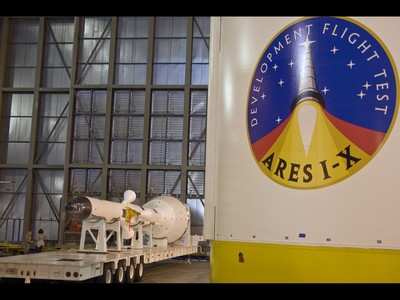First In A Series Of Updates On NASA's Next Manned Space
Program
by ANN Guest Contributor Wes Oleszewski
Pre-stacking of the Ares I-X vehicle has started in the VAB at
NASA's Kennedy Space Center, Florida. Key parts that will make up
the test launch vehicle have been arriving there since late 2008
and now the upper sections of the vehicle that will be the first
test of project Constellation hardware are beginning to take
shape.

Consisting of a single Space Shuttle SRB topped by a dummy upper
stage and mock-up of an Orion Service Module, Command Module and
Launch Abort System, the Ares I-X is scheduled for launch in the
second half of 2009 from Launch Complex 39B at KSC.
Ares I is intended to be the rocket that will one day send the
Orion spacecraft into low earth orbit. Orion will either tend to
the International Space Station or rendezvous with an earth
departure vehicle that will boost it and the Altair lunar landing
vehicle on a trajectory to the moon. The intention of this being to
replace the Space Shuttle as the primary means of access to space
for the United States. It is called the Constellation Program.
Ares I-X is designed to be the first step in flight testing of
the basic launch vehicle configuration. The flight will consist of
the SRB first stage boosting the simulated upper works, followed by
separation of the SRB and its parachute recovery. No recovery for
the simulated upper works is planned. The flight is aimed at
answering basic questions about stability and control of the stack
during first stage boost.

Working in an atmosphere of unknowns the Ares I-X team finds
themselves doing unexpectedly more with unexpectedly less. No one
really knows yet what the Obama Administration's plans for the Ares
launch vehicles will be. Meanwhile, the grand proposal of the
previous administration's "Vision for Space Exploration" that gave
birth to the Ares vehicles and the Ares I-X itself, was not
followed up by the funding needed to bring the program up to speed.
Following a tradition started back in 1970, when the Apollo program
was slashed, NASA has been forced to adapt and improvise the
Constellation Program within a flat budget. Over the past four
years NASA has found itself in the position of having to support
the new "vision" with far less funds than expected. This it has
done, however, and the first piece of heavy flight hardware has
started to take shape in the form of the Ares I-X.

On January 29 the simulated Command Module, (CM) arrived at the
VAB. At that same time the simulated Launch Abort System, aka the
escape tower, also arrived. The CM was "fit-checked" to the boiler
plate Service Module beginning February 18 as the basic parts of
the Ares I-X began to come together. As of this writing the upper
stage adapter was in the VAB and waiting to be checked out and then
moved, with the rest of the segments to the high bay for
stacking.

Although the Ares I vehicles remain held hostage to the
political whims of any given moment, the work on the Ares I-X
continues at KSC and the vehicle itself is moving toward vertical
stacking in the VAB's High Bay #4.
An avid space travel enthusiast and model rocket designer,
Wes is best-known as the creator of the "Klyde Morris" strip that
runs on Mondays and Fridays on ANN. More information on his rocket
designs is available here.
(ANN thanks NASA for use of its photos and images of the
Ares I-X)
 Classic Aero-TV: Pure Aerial Precision - The Snowbirds at AirVenture 2016
Classic Aero-TV: Pure Aerial Precision - The Snowbirds at AirVenture 2016 NTSB Final Report: Costruzioni Aeronautiche Tecna P2012 Traveller
NTSB Final Report: Costruzioni Aeronautiche Tecna P2012 Traveller ANN's Daily Aero-Linx (11.23.25)
ANN's Daily Aero-Linx (11.23.25) ANN's Daily Aero-Term (11.23.25): Request Full Route Clearance
ANN's Daily Aero-Term (11.23.25): Request Full Route Clearance Aero-News: Quote of the Day (11.23.25)
Aero-News: Quote of the Day (11.23.25)






